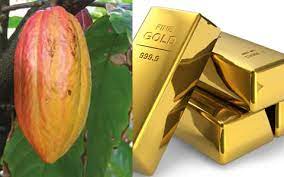Shea Butter as a Global Economic Product from Ghana
In the arid savannahs of northern Ghana, the shea tree — known locally as the “tree of life” — has sustained communities for centuries, remarked an Accra Business News writer. Once regarded primarily as a subsistence crop, shea has evolved into one of Ghana’s most promising global exports, valued not only for its cultural heritage but also for its economic and environmental potential.
Today, shea butter stands at the intersection of global beauty markets, sustainable agriculture, and women-led entrepreneurship. What was once a traditional product sold in local markets now anchors a multimillion-dollar export chain connecting rural Ghanaian women to cosmetic giants in Paris, London, and New York.
Ghana is among the world’s top producers of shea, second only to Nigeria. With global demand for natural and organic ingredients rising, the shea industry represents not just a local resource but a global opportunity — and one that Ghana is poised to capitalize on.
1. The Roots: Shea’s Cultural and Economic Origins
The shea tree (Vitellaria paradoxa) grows naturally across the West African savannah belt, spanning from Senegal to Uganda. In Ghana, it thrives particularly in the Northern, Upper East, Savannah, and Upper West Regions, providing vital income for rural households.
Traditionally, women harvest the shea nuts, boil, dry, and manually process them into butter for cooking, skincare, and medicinal purposes. For generations, this labor-intensive work has been both a cultural practice and an essential survival strategy in Ghana’s north.
In recent decades, shea butter’s global recognition as a natural moisturizer and base ingredient for cosmetics, chocolate, and pharmaceuticals has transformed the product into a valuable export commodity.
2. The Present: Shea as a Global Commodity
Shea butter has become one of Ghana’s fastest-growing agricultural exports. According to data from the Ghana Export Promotion Authority (GEPA), the country exports over 60,000 metric tonnes of shea products annually, generating hundreds of millions in revenue.
The global shea butter market, valued at over US$2.5 billion, is expected to continue growing as consumers and companies shift toward sustainable, plant-based ingredients. Ghana’s reputation for producing high-quality, organically sourced shea gives it a competitive advantage in this expanding market.
Export Value and Trade Partnerships
Ghana exports shea butter and shea nuts primarily to Europe, the United States, and Asia, where multinational corporations such as L’Oréal, The Body Shop, and Unilever source it for use in cosmetics, soaps, and lotions. Shea butter is also an alternative to cocoa butter in the chocolate industry — a lucrative niche given Ghana’s existing cocoa expertise.
The Ghana Cocoa Board (COCOBOD) has in recent years worked to integrate shea into national commodity export strategies, recognizing its potential to diversify agricultural revenue streams beyond cocoa and gold.
3. Women at the Heart of the Shea Economy
Perhaps the most inspiring dimension of Ghana’s shea industry is its role in women’s economic empowerment. Over 900,000 rural women are estimated to be directly involved in shea harvesting and processing.
Organizations such as the Ghana Shea Alliance, Savannah Fruits Company, and Global Shea Alliance (GSA) have helped formalize women’s cooperatives, improve production standards, and link communities to fair-trade and organic certification programs.
These cooperatives allow women to earn stable incomes, invest in education, and gain financial independence — transforming rural livelihoods and reducing poverty.
In many northern communities, shea has become more than a source of butter; it is a tool for inclusive development.
“Shea is not just a product — it’s empowerment wrapped in tradition,” says a cooperative leader in Tamale. “Every nut represents a woman’s strength and a family’s future.”
4. Sustainability and Climate Impact
Unlike many cash crops, shea trees grow wild and require no irrigation or chemical fertilizers, making them naturally sustainable. They also play a vital environmental role — protecting against desertification, enriching soil fertility, and serving as carbon sinks.
However, climate change and deforestation threaten shea tree populations. The clearing of trees for charcoal production, illegal logging, and expansion of farmlands are reducing shea parklands at alarming rates.
To counter this, the Ghana Forestry Commission, together with NGOs and the private sector, has launched reforestation initiatives under the Green Ghana Project, planting thousands of shea seedlings annually. Additionally, women’s cooperatives are being trained in sustainable harvesting practices to ensure long-term yields.
5. The Challenges: Value Addition and Market Access
Despite its potential, much of Ghana’s shea export remains in raw or semi-processed form, which limits value capture. Local producers often sell at low prices to international middlemen who then refine and brand the butter abroad for much higher profits.
To maximize returns, Ghana needs to scale local value addition — refining, packaging, and branding shea butter domestically for export.
The government’s One District, One Factory (1D1F) initiative has begun addressing this gap by supporting small-scale processing plants in the northern regions. The establishment of industrial zones in Tamale and Buipe for agro-processing could further strengthen shea’s export capacity.
Financial constraints also persist. Many women’s groups struggle with access to credit, modern equipment, and storage facilities. Furthermore, inconsistent quality control, limited packaging technology, and export certification costs hinder small businesses from reaching global markets.
6. The Future: Industrialization and Global Branding
The global beauty industry is shifting toward authenticity, sustainability, and ethical sourcing — values that align perfectly with Ghana’s shea sector.
To fully leverage this, Ghana must transition from being primarily a supplier of raw shea nuts to a global brand of finished shea products. This would mean:
-
Developing Ghanaian-owned cosmetic brands using locally sourced shea.
-
Expanding research and development (R&D) into product innovation (soaps, balms, creams, haircare).
-
Enforcing geographical indication (GI) status for Ghanaian shea to protect its origin and quality identity.
-
Partnering with AfCFTA to open continental export markets for value-added shea products.
Already, several homegrown brands such as Tama Shea, Kaeme, Nokware, and Skin Gourmet are proving that Ghana can compete on the global skincare stage with high-end organic products proudly made in Ghana.
7. Policy Outlook and Global Partnerships
The government’s National Export Development Strategy (NEDS) identifies shea as a key non-traditional export with potential to generate over US$1 billion annually.
International partners — including the United States Agency for International Development (USAID), UNDP, and World Bank — continue to invest in training, equipment, and certification to enhance Ghana’s export competitiveness.
The Global Shea Alliance, headquartered in Accra, plays a coordinating role between local producers, governments, and multinational buyers, ensuring ethical trade and fair value distribution along the supply chain.
With strong institutional support, Ghana could emerge not just as a top exporter but as the global leader in ethical shea production.
Conclusion: Ghana’s Golden Butter of the North
Shea butter is far more than a cosmetic ingredient — it is a story of heritage, sustainability, and empowerment. It embodies the intersection of traditional wisdom and modern enterprise, turning what once was a rural livelihood into a symbol of Ghana’s economic diversification and resilience.
If Ghana continues to invest in processing, quality assurance, and global branding, shea could rival cocoa as a major export earner. In a world moving toward sustainability and ethical consumption, Ghana’s “golden butter” holds immense promise — not only for the nation’s economy but for the dignity and prosperity of the women who make it possible.
Frequently Asked Questions (FAQs)
1. What is the economic value of shea butter to Ghana?
Shea butter generates hundreds of millions of dollars annually and employs nearly one million people, mostly women in northern Ghana.
2. Which regions in Ghana produce the most shea?
The Northern, Savannah, Upper East, and Upper West Regions are the main shea-producing areas.
3. What is shea butter used for internationally?
It is used in cosmetics, skincare, pharmaceuticals, and as a substitute for cocoa butter in the food industry.
4. What are the main challenges facing Ghana’s shea industry?
Challenges include limited value addition, financing constraints, climate change threats, counterfeit exports, and weak branding of locally made products.
5. How can Ghana increase value from shea exports?
By investing in local processing, securing quality certification, branding “Made in Ghana” shea products, and promoting industrial partnerships under AfCFTA.
Source: Accra Business News
Disclaimer: Some content on Accra Business News may be aggregated, summarized, or edited from third-party sources for informational purposes. Images and media are used under fair use or royalty-free licenses. Accra Business News, an extension of Accra Street Journal is a subsidiary of SamBoad Publishing Ltd under SamBoad Holdings Ltd, registered in Ghana since 2014.
For concerns or inquiries, please visit our Privacy Policy or Contact Page.
📢 GET FREE JOBS + TIPS
Others are getting instant job updates and career tips on our WhatsApp Channel. Why miss out?
📲 Join SamBoad Jobs Channel Now
















